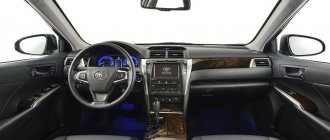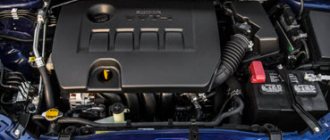Toyota Fortuner - Toyota Land Cruiser Prado: both have side member frames, independent suspension at the front and an axle at the rear, 2.8-liter diesel engine with a 6-speed automatic transmission, lowering and a 7-seater interior. Real! We have two almost identical cars, which even have very similar prices. Video test of Toyota Fortuner - Toyota Land Cruiser Prado below, technical specifications at the end of the article.
Please vote by reading the Toyota Fortuner - Toyota Land Cruiser Prado test, moving the MPS Index cursor along the scale that we offer at the beginning and end of the article.
Toyota couldn’t decide for a long time whether to expand the company’s model range in Russia with the Toyota Fortuner model or not, because the first generation SUV was not officially offered in our country. As a result, almost 2.5 years passed from the moment of the world debut of the second generation Fortuner until the Russian representative office of the brand decided to start sales.
For a basic Toyota Fortuner they ask for exactly 2 million rubles, and the Prado will cost 200 thousand more. If we compare diesel versions, like ours, then the price is correspondingly 2.6 million rubles. for Fortuner and 2.92 million rubles for Prado. Is it worth overpaying, and in general, why does Toyota need two very similar cars?
Over the 2 months of sales since its debut at the end of October 2021, 1,270 buyers voted for Fortuner in rubles. The updated Prado showed growth during the same period of time and showed a result of 4,070 cars sold. We looked for the answer to the question of whether it is worth overpaying for the status of the Prado, and whether the Fortuner is so hardy, in the snow-covered forests of the Moscow region and on the icy track of the training ground.
Toyota Fortuner
The appearance of the car is quite “aggressive”, but attractive and harmonious for an SUV. The design of the front end immediately attracts attention: narrow headlights with stripes of running lights, a chrome radiator grille, a brutal wide bumper of complex shape, subtle arches, sills with running boards, 17 or 18 inch wheels.
The body metal is rust resistant. The lanterns are plastic, but, as practice shows, they do not become cloudy for a long time. One of the disadvantages is the low protection of the painted body from scratches caused by pebbles and sand flying from under the wheels. This drawback is easy to fix; just stick a protective film on the parts that are susceptible to scratches.
The Fortuner's interior is Japanese-style: a complex angular shape of the center console, a practical, neat instrument panel, an ergonomic steering wheel, and square rear seats. Interior materials: leather, metal, plastic and small wooden inserts.
The cabin can accommodate up to seven people. But Fortuner owners note that only children can sit comfortably in the rear seats; these seats are no different in terms of space.
In very deep snow
Fortuner is rear-wheel drive under normal conditions, front-wheel drive is rigidly connected.
Prado with permanent all-wheel drive; moreover, in the arsenal of a more expensive SUV there is the opportunity to choose from an abundance of electronic assistants that make driving off-road easier (active traction control, hill-descent and hill-assist systems, systems for maintaining a constant speed on off-road), and Our version provides the possibility of forced locking of the rear cross-axle differential.
On both cars, all-wheel drive is controlled by electronics, and although both Fortuner and Prado have a range of downshifts, in modern cars cross-country ability depends not only on the driver’s skill, but also on artificial intelligence.
It is better not to take it to extremes: the front towing eye on the Prado is located extremely inconveniently, and the need to use it off-road will not meet the owner’s enthusiasm, unless, of course, he is a fan of off-roading.
The ground clearance of the Toyota Fortuner is 10 mm greater than that of the Toyota Land Cruiser Prado (225 versus 215 mm). A strong feature of the Prado is driver friendliness: even the least experienced owner will be protected by electronics on rough terrain. Potentially, the Fortuner is not inferior to the Prado in terms of off-road potential, however, in order to realize it, the Fortuner must be driven by a sophisticated driver.
At first glance, it may seem that the presence of locking rear and central differentials, as well as assistive electronics, can replace large suspension travel, but even when using its full off-road potential in deep snow, we clearly found that the Prado will go a little further than the Fortuner.
To increase comfort, the Prado boasts rear air suspension with height adjustment. This does not affect the ground clearance, since it remains unchanged under the engine protection and rear axle housing. But the air suspension allows you to maintain a constant body height regardless of the load, and it will also come in very handy when loading the car or, for example, when towing a heavy trailer. You can lower the stern to the down position, drive under the trailer tongue, and then lift the vehicle.
And, of course, the mass of auxiliary electronics, which in the Prado has almost reached the level of the Land Cruiser 200. In winter conditions, we did not find any sense in it. Under full throttle and from acceleration, it goes noticeably further than with the help of assistants. And if you sit down, take a rope or a shovel, whichever is closer.
At a meeting with friends, the owner of the new Prado will have something to brag about. There is MTS – Multi-Terrain Select. This is a puck with which the driver can choose one of six types of off-road terrain that he is now going to conquer. You can also set the speed of off-road cruise control. The main thing in the heat of battle is not to mix up the pucks. Previously, the Prado had one puck, but now there are two. One is responsible for electronic assistants, and the second is quite serious - it turns on the lowering control.
There are still three buttons next to the selector, but they now have five powertrain operating options: Eco, Normal, Sport, Sport S and Sport S+. This, of course, does not add speed, especially when there is a 177-horsepower diesel engine under the hood, and the car’s weight noticeably exceeds 2 tons, but you can boast about it - almost like a Mercedes AMG.
While the Prado is clean, 4 all-round cameras and an interesting “transparent hood” feature will be very useful. The system records an image from the front camera and, as the car moves forward, an image of what the wheels are currently moving on is displayed on the screen. True, in the snow there is zero help from such a system. An X-ray or an echo sounder would be more useful here, but these are just fantasies.
Toyota-Land-Cruiser-Prado: The center console in the interior has been noticeably updated. It became a little lower, which, together with the central depression on the hood, improved visibility. Just like on a 200, the driver can better see the track along which the right wheel goes. Sunroof - you always know where the sun is.
Fortuner, of course, does not have all of the above, and this is what makes it more accessible and more reliable. The KDSS system, adjustable shock absorbers, and especially air suspension in severe off-road conditions do not potentially exclude problems. Toyota Fortuner can be safely plunged into the snow and swamps. We even jumped on it from a rather large slide ( see video
), we thought it would fall apart, but no, it landed and then jumped again.
The only thing that may cause concern to the Fortuner owner is the electric transfer case. If there had been an ordinary poker instead, many would have been happy.
the video for details on how to deal with deep snow.
: in a real situation, both cars had to be pulled out; it’s good that they did it without a tractor. In a pair of Toyota Fortuner - Toyota Land Cruiser Prado - the latter will drive further in deep snow.
Toyota Land Cruiser Prado
No offense to other brands, but Prado is the most common SUV on Russian roads . It was developed on a platform that was universal for the manufacturer. The car turned out stylish and luxurious, the bet on the European studio that designed the body paid off: massive sills, vertical stoppers, wide headlights and a bumper - the result was a real “masculine” car.
Prado is an SUV on a frame, which ensures structural strength and high off-road confidence. One of the disadvantages is the low protection of the frame from rust at welding joints. Therefore, owners recommend immediately treating problem areas with special compounds.
There are practically no complaints about the interior. High-quality leather, metal and plastic last for many years. Among the minuses, we note that the windshield becomes cloudy over time and malfunctions in the climate control system.
Common features of Fortuner and Prado
Despite the fact that both cars are built on different bases, they have a lot in common. This applies to both appearance and internal technical characteristics. Fortuner is maximally interchangeable with spare parts from Prado , which are widespread, speaks for itself
Both the first and second cars have a frame layout with independent suspension and all-wheel drive. On gravel they perfectly “smooth out” unevenness. But due to the high center of gravity, cars tend to fall over at speed. They have this “disease” in common.
Differences and characteristics of Fortuner and Prado
- The Fortuner has a 2.8-liter diesel engine (177 horsepower). The Prado has a 2.7 liter petrol engine as standard. and 173 horses.
- Torque Fortuner - 450 Nm , Prado - 241 Nm .
- The Fortuner picks up speed well, accelerating to hundreds in 10.8 seconds, and the maximum speed reaches 180 km/h. The Prado's performance characteristics are not bad, but not as outstanding as those of its competitor. Considering the weight of this SUV, acceleration and resource are somewhat lower than those of the Fortuner.
- In terms of fuel consumption, the Fortunet also surpasses its rival, 11 liters per hundred kilometers on asphalt; outside the city, the figure drops to 7.3 liters. The Prado is distinguished by an unfinished crankcase ventilation system, rapid contamination of equipment, which ultimately leads to increased fuel consumption.
- Ball joints on Fortuner become unusable at 280 thousand km, by which time the rear axle shaft seal may need to be replaced. Prado is more vulnerable in this sense; ball joints and rubber bands of levers will require repairs by 250 thousand km. More often the front suspension of the Prado suffers.
- The Fortuner has disc brakes on both axles. The average time for replacing pads is 90 thousand km. Steering ends are durable and do not need to be replaced for many years. The Prado's brake pads are also not bad, but due to the high weight of the car they have to be changed more often. But the tips of the Prado are the weakest point. They have to be changed frequently, since their service life is short.
- In terms of price category, the cars differ little, if you focus on the new versions. However, Prados have been “living” in Russia for quite a long time, and you can find cars from the first years of production at a price of 750-800 thousand rubles . More recent models (from 2009) cost approximately 1.7-1.9 million rubles . Fortuner reached our market relatively recently, so the price of a car averages 2.6 million rubles .
Toyota Fortuner - Toyota Land Cruiser Prado for real men
The new Fortuner is the company’s second model, after the Hilux pickup, built on the IMV platform. The “trolley” is based on the most durable Heavy Duty type spar frame among civilian Toyotas, and the manufacturer positions the Fortuner as an SUV designed for operation in difficult conditions, but not utilitarian in terms of equipment: the list of options includes quite “civilian” climate control, multimedia with 7-inch display, leather interior, stability control system and other attributes of comfort and safety.
In total, Toyota has 3 options for the spar frame: Heavy Duty, which is used on the Fortuner and pickup truck (they differ in length and rear suspension, but the frame design is very similar), Light Duty is used on the Prado and Premium for and.
Already from the very designation of the frame one can understand that the Fortuner, assembled in Thailand, is created for more complex work, while the Prado is closer to premium. The same can be said about the all-wheel drive design. If the Fortuner, like the , uses a simpler and cheaper Part-time scheme with permanent rear-wheel drive and a rigid connection of the front end, then the Prado has a more advanced permanent all-wheel drive with a differential. Although, if desired, it can be blocked. There are lowering units on both cars.
The Prado's suspension design is also more advanced. In expensive versions, it is equipped with switchable KDSS anti-roll bars. In the city their presence does not reveal itself at all. In terms of roll level, the Prado is quite comparable to the Fortuner, but off-road the stabilizers stop preventing the axles from crossing, and on very steep bends, where the Fortuner hangs the rear wheel, the Prado still holds.
The Fortuner's competitor in our test, and on the Russian market, is a fellow concern, a long-time bestseller in its segment, the Land Cruiser Prado, which recently underwent another update. At the heart of the Toyota Land Cruiser Prado, the Light Duty frame is a compromise between comfort and off-road performance. And, although Prado is a self-explanatory brand, a “timeless” car with an army of loyal fans, Fortuner with exactly the same engine and similar equipment is 300 thousand rubles cheaper.
The cars on test have the same 2.8-liter diesel 177-horsepower engines, 6-speed automatic transmissions, and are shod with identical tires, so both in stopwatch competitions and off-road, the features of the transmission and chassis settings will come to the fore.
Fortuner or Prado: what to choose?
In terms of its status, the Fortuner occupies a niche somewhat lower than the Prado. But despite this, it looks somewhat more modern. If we take into account the technical comparison, then both for the city and for off-road use this car noticeably wins in terms of durability.
According to the price criterion, both cars are approximately at the same level. When choosing a Fortuner, it is important to remember the cost of maintaining this car. The diesel engine turbine and suspension arms may be a significant repair expense.
When choosing a Prado, you need to take into account a much larger list of possible breakdowns, but in terms of the cost of repairs and replacement of parts, the Prado noticeably wins. The spare parts market for this car is so wide that competition between sellers significantly affects the cost of parts that are sold on “every corner”.
Auto and motorcycleComment
We're driving in a slippery circle
Compared to the Land Cruiser Prado, the Toyota Fortuner is 100 kg lighter and, with the same 177-horsepower diesel engine, it feels a little more dynamic. Although I still don’t want to ride it recklessly. Toyota doesn't even list a 0-60 mph time. But given that the Prado does the sprint in 12.7 seconds, we can assume that the Fortuner should leave in 12.5 seconds. It’s still not fast, but it’s even more scary to turn on it.
When turning the steering wheel quickly, the Toyota Fortuner sometimes bites the steering wheel, although the Toyota Land Cruiser Prado does not have such a problem.
Our goal during the fast lap is, of course, to find out who is faster, but not in order to choose the best SUV for racing, but to get an idea of how these monsters will behave in an emergency situation, for example, if necessary to dodge an obstacle on the track.
On the fast lap, oddly enough, Prado was better, although he lost a little in seconds. Yes, it's a little heavier, but the better suspension, even without electronic assistance, clearly helps it. The steering wheel is lighter and more accurate, and the ergonomics are better.
During dynamic runs on packed snow, the Fortuner turned out to be faster than the heavier Prado, but only by a few moments - 0.3 seconds. At the same time, the Fortuner was inferior to the Prado in terms of handling and ride comfort: the Fortuner’s rigidity is tiring, and what was initially taken for brutality looks ponderous and even excessive during active use.
The fresh appearance and refined interior have not changed the essence of the Fortuner - first of all, this is a car for overcoming, and not for solving routine tasks.
Toyota-Fortuner: the second row is spacious and comfortable.
Toyota-Fortuner: there may be a third row of seats.
Toyota-Fortuner: Our snow removal equipment is at ease here.
Toyota-Land-Cruiser-Prado in position - two rows of seats.
Toyota-Land-Cruiser-Prado - the second row is spacious.
Conclusion: Toyota Fortuner - Toyota Land Cruiser Prado - both are real! If you want to save money, Fortuner will help.
In contrast to the huge margin of safety of the Fortuner, the Land Cruiser Prado does not flex its muscles in vain: it is a universal, liquid vehicle, whose advantages are passed on from generation to generation.
Toyota Fortuner is new, it is young, but still green. Perhaps somewhere in the outback his less noble manners will come in handy, but for a city dweller he is not yet up to the task.
Manufacturer's pricing policy: Toyota Fortuner - Toyota Land Cruiser Prado.
After the appearance of gasoline versions on the Russian market, the base price for
the Fortuner
dropped to 2 million rubles, which is exactly what official dealers are asking for a car with a 2.7-liter gasoline engine with a capacity of 166 hp.
and a 5-speed manual transmission in the “Standard” configuration. For a 6-automatic transmission and the next “Comfort” package with it, you will have to pay an additional 385 thousand. The richest versions of “Elegance” and “Prestige” are available only with a diesel unit (from 2.638 million rubles). The Prado configurator
offers options that dealers do not equip the Fortuner with at any cost. The price range is almost double: if the “Classic” version is estimated at 2.289 million rubles, then the “Safety Luxury” starts at 4.089 million rubles! A choice of 2 petrol and diesel engines, 5-speed manual transmission or 6-automatic transmission, 5- or 7-seat interior configuration, in addition, a wide range of additional equipment is available for the Land Cruiser Prado.
From the author of the blog site Peter Menshikh: I thank Igor Sirin (co-author and presenter on the video), Konstantin Tereshchenko (presenter on the video), Roman Kharitonov (editor), Evgeniy Mikhalkevich (cameraman) for their participation in the preparation of the material.
Video test of Toyota Fortuner - Toyota Land Cruiser Prado below, technical specifications at the end of the article.











